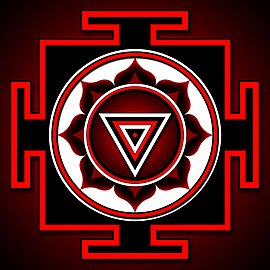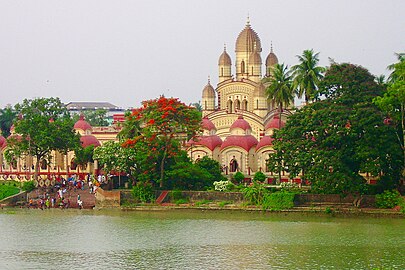Sakta
| Artikel ini adalah bagian dari seri |
| Sakta |
|---|
 |
| Ketuhanan tertinggi
|
| Perwujudan Mahadewi
|
| Pustaka suci
|
| Sampradaya (tradisi)
|
| Filsuf (acarya)
|
| Lainnya
|
| Portal agama «Hindu» |
|
Sakta atau Saktam (Dewanagari: शाक्तं; ,IAST: Śāktaṃ,; arti harfiah: "ajaran Sakti" atau "ajaran tentang para dewi") adalah aliran dalam agama Hindu yang berfokus pada pemujaan Sakti atau Dewi—Ibu Dewi bagi umat Hindu—sebagai Tuhan Yang Maha Esa dan Mahakuasa. Beserta Saiwa dan Waisnawa, Sakta merupakan salah satu aliran utama Hinduisme.
Umat Sakta memandang Dewi sebagai Brahman—Yang Maha Esa—dengan beragam wujud ilahi, baik wanita ataupun pria, yang dianggap sebagai aneka manifestasi-Nya semata. Dalam rincian filsafat dan praktik keagamaan, Sakta mirip dengan Saiwa. Akan tetapi, umat Sakta memuja seluruh manifestasi Sakti sebagai aspek kewanitaan yang dinamis dari Tuhan Yang Mahakuasa. Siwa—sebagai aspek kejantanan dari Tuhan—dianggap transenden, dan pemujaan kepada-Nya dianggap sebagai pelengkap saja.[1]
Penganut Sakta meyakini Sakti sebagai kekuatan yang mendasari segala prinsip-prinsip kelakian, sedangkan Dewi biasanya digambarkan sebagai Parwati (pasangan Siwa) atau Laksmi (pasangan Wisnu). Ia dapat pula digambarkan dengan wujud berbeda, seperti Kali atau Durga yang menyeramkan. Sakta erat kaitannya dengan Hinduisme Tantra, yang mengajarkan ritus dan praktik pembersihan pikiran dan raga.[2][3][4] Umat Sakta memakai mantra, sihir, gambar sakral, yoga, dan ritual untuk memanggil kekuatan-kekuatan kosmis.[5]
Dalam rentang sejarahnya, Sakta telah menjadi sumber bagi beberapa sastra Sanskerta dan filsafat Hindu, dan masih memberi pengaruh kuat bagi Hinduisme populer pada masa kini. Aliran Sakta dianut di sebagian besar wilayah India dan luar India, dalam berbagai tradisi, baik bersifat Tantra maupun tidak; akan tetapi, aliran Sakta yang terbesar dan sering teramati adalah Srikula (pemujaan kepada Sri), terutama di India Selatan, dan Kalikula (pemujaan kepada Kali), yang bertahan di India Utara dan Timur.[1]
Galeri
- Ibu Dewi Sri Lalita Tripura Sundari
-
 Ibu Dewi Sri Kali
Ibu Dewi Sri Kali -

-
 Sri yantra
Sri yantra -
 Kali yantra
Kali yantra -
-
 Kuil Kali Dakshineswar (Kolkata, Benggala Barat)
Kuil Kali Dakshineswar (Kolkata, Benggala Barat) -
 Kuil Lalita «Dewipuram» (Visakhapatnam, Andhra Pradesh)
Kuil Lalita «Dewipuram» (Visakhapatnam, Andhra Pradesh)
Referensi
Daftar pustaka
- Bhattacharyya, N. N. (1996) [1974]. History of the Sakta Religion (edisi ke-2nd). New Delhi: Munshiram Manoharlal Publishers.
- Bhattacharyya, N. N. (1977) [1970]. The Indian Mother Goddess (edisi ke-2nd). New Delhi: South Asia Books.
- Brooks, Douglas Renfrew (1990). The Secret of the Three Cities: An Introduction to Hindu Shakta Tantrism. Chicago: The University of Chicago Press. ISBN 978-0-226-07569-3.
- Brooks, Douglas Renfrew (1992). Auspicious Wisdom: The Texts and Traditions of Srividya Shakta Tantrism in South India. Albany: State University of New York Press. ISBN 978-0-7914-1146-9.
- Brown, C. MacKenzie (1991). The Triumph of the Goddess: The Canonical Models and Theological Issues of the Devi-Bhagavata Purana. SUNY Series in Hindu Studies. State University of New York Press. ISBN 978-0-7914-0364-8.
- Brown, C. Mackenzie (1998). The Devi Gita: The Song of the Goddess: A Translation, Annotation and Commentary. Albany: State University of New York Press. ISBN 978-0-7914-3940-1.
- Dasgupta, S (1996). Journal of the Indian Musicological Society. 27–28. Indian Musicological Society.
- Dempsey, Corinne G. (2006). The Goddess Lives in Upstate New York: Breaking Convention and Making Home at a North American Hindu Temple. New York: Oxford University Press.
- Dikshitar, V. R. Ramachandra (1999) [1942]. The Lalita Cult. Delhi: Motilal Banarsidass Publishers Pvt. Ltd.
- Fell McDermett, Rachel (1998). "The Western Kali". Dalam Hawley, John; Wulff, Donna Marie (eds.). Devi: Goddesses of India. Motilal Banarsidass Publ. ISBN 978-81-208-1491-2. Pemeliharaan CS1: Menggunakan parameter penyunting (link)
- Hawley, John Stratton (1998). "The Goddess in India". Dalam Hawley, John; Wulff, Donna Marie (eds.). Devi: Goddesses of India. Motilal Banarsidass Publ. ISBN 978-81-208-1491-2. Pemeliharaan CS1: Menggunakan parameter penyunting (link)
- Joshi, M. C. (2002). "Historical and Iconographical Aspects of Shakta Tantrism". Dalam Harper, Katherine; Brown, Robert L. (eds.). The Roots of Tantra. Albany: State University of New York Press. ISBN 978-0-7914-5305-6. Pemeliharaan CS1: Menggunakan parameter penyunting (link)
- Kali, Davadatta (2003). In Praise of the Goddess: The Devimahatmya and Its Meaning. Berwick, ME: Nicolas-Hays, Inc.
- Kapoor, Subodh (2002) [1925]. A Short Introduction to Sakta Philosophy. New Delhi: Indigo Books.
- Kinsley, David (1987). Hindu Goddesses: Visions of the Divine Feminine in the Hindu Religious Tradition. Motilal Banarsidass Publ. ISBN 978-81-208-0394-7.
- Kinsley, David (1998). Tantric Visions of the Divine Feminine: The Ten Mahavidyas. Motilal Banarsidass Publ. ISBN 978-81-208-1523-0.
- Krishna Warrier, A. J. (1999) [1967]. The Sākta Upaniṣads. The Adyar Library and Research Center, Library Series. 89 (edisi ke-3rd.). Chennai: Vasanta Press.
- McDaniel, June (n.d.). "Bengali Shakta". Countries and Their Cultures. Advameg, Inc.
- Nikhilananda, Swami (trans.) (2000) [1942]. The Gospel of Sri Ramakrishna (edisi ke-9th). New York: Ramakrishna-Vivekananda Center.
- Pattanaik, Devdutt (2000). Devi the Mother-Goddess: An Introduction. Mumbai: Vakils, Feffer and Simons Ltd.
- Pechilis, Karen (ed.) (2004). The Graceful Guru: Hindu Female Gurus in India and the United States. New York: Oxford University Press. Pemeliharaan CS1: Teks tambahan: authors list (link)
- Subramuniyaswami, Satguru Sivaya (2002) [1999]. Merging with Siva: Hinduism's Contemporary Metaphysics (edisi ke-2nd). Hawaii: Himalayan Academy. ISBN 978-0-945497-99-8.
- White, David Gordon (2003). Kiss of the Yogini: "Tantric Sex" in its South Asian Contexts. Chicago: University of Chicago Press. ISBN 978-0-226-89483-6.
- Woodroffe, Sir John (1951) [1927]. Sakti and Sakta: Essays and Addresses on the Shâkta Tantrashâstra. Ganesh & Company. ISBN 978-1-60620-145-9.
- Yadav, Neeta (2001). Ardhanārīśvara in Art and Literature. New Delhi: D. K. Printworld (P) Ltd.
- Lynn Foulston; Stuart Abbott (2009). Hindu Goddesses: Beliefs and Practices. Sussex Academic Press. ISBN 978-1-902210-43-8.
- Bolon, Carol Radcliffe (1992). Forms of the Goddess Lajja Gauri in Indian Art. University Park, PA: Penn State University Press.
- Erndl, Kathleen M. (1992). Victory to the Mother: The Hindu Goddess of Northwest India in Myth, Ritual, and Symbol. New York: Oxford University Press.
- Johnsen, Linda (2002). The Living Goddess: Reclaiming the Tradition of the Mother of the Universe. Yes International. ISBN 978-0-936663-28-9.
- Joshi, L. M. (1998). Lalita Sahasranama: A Comprehensive Study of the One Thousand Names of Lalita Maha-tripurasundari. New Delhi: D.K. Printworld (P) Ltd.
- C Mackenzie Brown (1990). The Triumph of the Goddess: The Canonical Models and Theological Visions of the Devi-Bhagavata Purana. State University of New York Press. ISBN 978-0-7914-0364-8.
- Cheever Mackenzie Brown (1998). The Devi Gita: The Song of the Goddess: A Translation, Annotation, and Commentary. State University of New York Press. ISBN 978-0-7914-3939-5.
- Coburn, Thomas B. (1991). Encountering the Goddess: A translation of the Devi-Mahatmya and a Study of Its Interpretation. State University of New York Press. ISBN 0791404463.
- Coburn, Thomas B. (2002). Devī Māhātmya, The Crystallization of the Goddess Tradition. South Asia Books. ISBN 81-208-0557-7.
- Lynn Foulston; Stuart Abbott (2009). Hindu Goddesses: Beliefs and Practices. Sussex Academic Press. ISBN 978-1-902210-43-8.
- John Stratton Hawley; Donna Marie Wulff (1998). Devi: Goddesses of India. Motilal Banarsidass. ISBN 978-81-208-1491-2.
- Alf Hiltebeitel; Kathleen M. Erndl (2000). Is the Goddess a Feminist?: The Politics of South Asian Goddesses. New York University Press. ISBN 978-0-8147-3619-7.
- Kali, Davadatta (2003). In Praise of the Goddess: The Devimahatmya and Its Meaning. Motilal Banarsidass. ISBN 8120829530.
- Manna, Sibendu, Mother Goddess, Chaṇḍī, Punthi Pustak, Calcutta, India, 1993. (ISBN 81-85094-60-8)
- June McDaniel (2004). Offering Flowers, Feeding Skulls. Oxford University Press. ISBN 978-0-19-534713-5.
- Jyotir Maya Nanda. Mysticism of the Devi Mahatmya Worship of the Divine Mother. South Miami, Fla: Yoga Research Foundation, 1994. ISBN 0-934664-58-7
- Tracy Pintchman (2005). Guests at God's Wedding: Celebrating Kartik among the Women of Benares. State University of New York Press. ISBN 978-0-7914-6595-0.
- Tracy Pintchman (2014). Seeking Mahadevi: Constructing the Identities of the Hindu Great Goddess. State University of New York Press. ISBN 978-0-7914-9049-5.
- Tracy Pintchman (2015). The Rise of the Goddess in the Hindu Tradition. State University of New York Press. ISBN 978-1-4384-1618-2.
- Rocher, Ludo (1986). The Puranas. Otto Harrassowitz Verlag. ISBN 978-3447025225.
- Sarma, S. A. (2001). Kena Upanisad: A Study From Sakta Perspective. Mumbai: Bharatiya Vidya Bhavan.
- Shankarnarayanan, S. (2002b) [1971]. Sri Chakra (edisi ke-4th). Chennai: Samata Books.
- Smith, Frederick M. (2006). The Self Possessed: Deity and Spirit Possession in South Asian Literature. Columbia University Press. ISBN 0-231-13748-6.
- Suryanarayana Murthy, C. (2000) [1962]. Sri Lalita Sahasranama with Introduction and Commentary. Mumbai: Bharatiya Vidya Bhavan.
- Urban, Hugh B. (2003). Tantra: Sex, Secrecy, Politics and Power in the Study of Religion. Berkeley: University of California Press. ISBN 978-0-520-93689-8.
- Winternitz, M. (1973) [1927]. History of Indian Literature. New Delhi.
 | Artikel bertopik agama Hindu ini adalah sebuah rintisan. Anda dapat membantu Wikipedia dengan mengembangkannya. |
- l
- b
- s

















